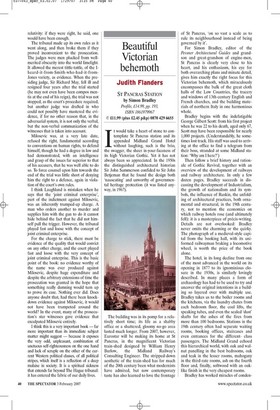Beautiful Victorian behemoth
Judith Flanders ST PANCRAS STATION by Simon Bradley Profile, £14.99, pp. 193, ISBN 1861979967 © £11.99 (plus £2.45 p&p) 0870 429 6655 1 t would take a heart of stone to contemplate St Pancras station and its appended Midland Grand Hotel without laughing, such is the brio, the swagger, the sheer in-your-faceness of its high Victorian Gothic. Yet it has not always been so appreciated. In the 1950s the distinguished architectural historian Sir John Summerson confided to Sir John Betjeman that he found the design both 'nauseating' and unworthy of governmental heritage protection (it was listed anyway, in 1967).
The building was in its pomp for a relatively short time; its life as a shabby office or a shuttered, gloomy no-go area lasted much longer. From 2007, however, Eurostar will be making its home at St Pancras, in the magnificent Victorian train-shed designed by William Henry Barlow, the Midland Railway's Consulting Engineer. The stripped-down aesthetic of the train-shed has for much of the 20th century been what modernists have admired, but now contemporary taste has also learned to love the frontage of St Pancras, 'on so vast a scale as to rule its neighbourhood instead of being governed by it'.
For Simon Bradley, editor of the Pevsner Architectural Guides and grandson and great-grandson of engine-men, St Pancras is clearly very close to his heart, and his enthusiasm, his eye for both overarching plans and minute detail, gives him exactly the right focus for this Victorian behemoth, which miraculously encompasses the bulk of the great cloth halls of the Low Countries, the tracery and windows of 13th-century English and French churches, and the building materials of northern Italy in one harmonious whole.
Bradley begins with the indefatigable George Gilbert Scott: from his first project when he was 22 to his death, aged only 67, Scott may have been responsible for nearly 1,000 projects. (Understandably, he sometimes lost track. His staff was used to arriving at the office to find a telegram from their boss, stranded at some Midland station: 'Why am I here?') Then follow a brief history and rationale of Gothic Revival, together with an overview of the development of railways and railway architecture. In only a few dozen pages, Bradley succeeds in discussing the development of Industrialism, the growth of nationalism and its symbols, the influence of Ruskin, the unfolding of architectural practices, both ornamental and structural, in the 19th century, not to mention the economics on which railway hotels rose (and ultimately fell): it is a masterpiece of précis-writing. Details are not overlooked: Bradley never omits the charming or the quirky. The photograph of a medieval-style capital from the booking hall, with its uniformed railwayman braking a locomotive wheel, is worth the price of the book alone.
The hotel, in its long decline from one of the most advanced in the world on its opening in 1877 to its ignominious closure in the 1930s, is similarly lovingly described. In many places a form of archaeology has had to be used to try and uncover the original intentions in a building so layered over with multiple use. Bradley takes us to the boiler rooms and the kitchens, via the laundry chutes from each bedroom floor, the coal lifts, the speaking tubes, and even the sealed 'dust' shafts for the ashes of the fires from more than 100 bedrooms. Stations in the 19th century often had separate waiting rooms, booking offices, staircases and even entrances for the differentclass passengers. The Midland Grand echoed this hierarchical world, with oak and walnut panelling in the best bedrooms, oak and teak in the lesser rooms, mahogany in the third-rate rooms, ash on the fourth floor and, finally, softwood with an oaklike finish in the very cheapest rooms.
Bradley has worked miracles of condensation: there is nothing in this book that I am not happy to know; much more of it is valuable to know; all of it is a pleasure to know. My only quibble is that St Pancras station has been published in a small series entitled 'Wonders of the World'. St Pancras is certainly a marvel, but even Bradley's wit, passion and charm cannot persuade me that Scott's Gothic wonderhouse ranks with the Parthenon, the Alhambra and the Taj Mahal. Yet so persuasive a guide is he that I am prepared to consider that the limitation might be mine, not the building's.





















































 Previous page
Previous page